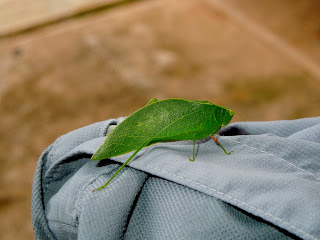 |
| Getting the bed ready |
We have just finished our final week of Agriculture/Environment based training in Woodford. Like the week before, we were engaged in practice-based experiential learning. The highlight for me was the Farmer Field School that we facilitated. We also did some more work in hillside farming and companion cropping. The local extension agents from the Rural Agriculture Development Authority (RADA) spent a lot of time with us sharing their technical knowledge as well as their experiences working in the Jamaican context.
On Tuesday, we finished breaking ground in our hillside plot and inter-cropped tomatoes with scallions (the odor of the scallions repels bugs from tomatoes). This involved breaking up the soil with a large hoe and turning the soil with a large fork. Once the ground was broken up and leveled back out, we used the end of a machete to carve out little holes for the seedlings. After getting the seedlings firmly in the ground and adding a little water, we were done for the day. It all got done pretty quickly with about twelve people working at any given time.
Wednesday the RADA marketing officer for St. Andrew parish came to speak with us. I found it interesting that a lot of his work revolves around linking farmers with buyers, whereas most farmers in the U.S. have the ability to carry out this function for themselves. I look forward to learning more about the knowledge and information systems available to farmers and how varied levels of literacy affect access to these systems.
Thursday morning we held the Farmer Field School (FFS). Usually, a FFS consists of many sessions over the course of a growing season, so one could argue it wasn’t technically a FFS since it was a one-off event. Regardless, it was a good opportunity for us to become familiar with the model and to experience facilitating farmer-centered training. The official start time for the event was announced as 8:30am, but by 9:00 we had about three people. A few minutes later we were up to about seven, and then by 10:00 we had 16 participants (a lesson in “island time”). Since many of the farmers had met with us the week prior for a general discussion, we started by revisiting a few of their main concerns related to market prices and availability of market information. Since these are things that an individual farmer has little control of, we shifted the focus to another way of making more money: reducing input costs. The problem is few farmers keep records of their expenditures, so they have no idea what their cost of production is for any given crop. The intent was for the farmers to become aware of their costs and identify ways of increasing the profit margin by reducing inputs. Two or three seemed interested enough adopt the practice. As part of this session, we introduced the farmers to the Jamaica Agriculture Market Information System (JAMIS). JAMIS is a new online tool that makes weekly market prices available at various points in the chain: farmgate, municipal, wholesale, and retail. It is a pretty extensive database that relies on input from the RADA marketing officers in each parish. The idea is to make pricing more transparent and to help farmers identify better opportunities. The participant that showed the most interest in this was "Ziggy", a twenty-something farmer with a high level of literacy and business sense. It would be interesting to see how he utilizes the JAMIS system to build his enterprise.
 |
| Making pesticide from neem |
Other sessions in the FFS included making natural pesticides from neem tree leaves as well as household items like dish soap, garlic, pepper, and vinegar.A few farmers seemed interested in trying it because it is cheaper and safer to apply. Keep in mind; many of these farmers have less than two acres. Some of them were already using this technology and it resulted in good discussion within the group. For the last session, we had the farmers teach us how and why they plant certain crops according to the moon phases. The farmers really enjoyed taking on the role of teacher and we certainly learned a lot; the first quarter is a busy time for farmers! All in all the FFS was a great experience and I hope to be involved in regular training like this when I get to my permanent site.
Thursday evening we had a big potluck where all the host families and trainees got together. Many of the trainees cooked dishes too, so there was a variety of food to choose from. Most people went home with belly aches from overeating. We really enjoyed ourselves and we could tell that the families we have been with genuinely cared for us and appreciated having us stay with them for these five weeks.
Friday was spent reviewing all we have covered in training and wrapping up some administrative items in the morning. In the afternoon we worked on a special presentation we will be making in Kingston on Monday when we reconvene with the rest of Group 83 (Youth as Promise & Education sectors). I won’t give away any of the details now, but it should be pretty awesome.
 |
| Well camoflauged insect I found on my shirt |
Monday afternoon, Linnae and I will find out exactly where we will be living and the Jamaican counterparts we will work with over the next two years. On Tuesday we will meet these counterparts and they will take us to our little spot on the island. We will stay there for four days and then return to Kingston for some final training as a group which will culminate with a swearing in ceremony on the 18th and the beginning of 24 months of agricultural teaching, research, and outreach.
No comments:
Post a Comment